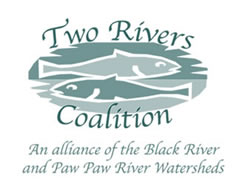3-October-2010, Leg 5
48th Ave Bridge to the Paw Paw St Bridge in the Village of Lawrence
On Sunday, Oct. 3, I put in at the newly rebuilt bridge on 48th Ave and resumed paddling towards Lawrence. Water level was low and there were a lot of obstacles to be jumped, squeezed under, etc. I had to get out and haul my kayak 10 different times... Interestingly, I noticed a change in the topography. Most of the time you could observe a high bank on one side of the river or the other. The practical effect of this is to limit the size of the forested floodplain to the opposite bank since farmers plow to the edge of the high bank. As we learned at the last TRC annual meeting, some species such as prothonatory warbler will only nest in large areas of forested floodplain at least several hundred yards wide. The other consequence of a high bank near the river is that homes can be built close to the water [especially near roads and bridges]. Some homes I saw blended into the riverbank environment well with minimal impact, however, other homes had mowed lawns extending all the way to the water's edge. Not only is this bad from an aesthetic standpoint, but ecologically as well. Wildlife needs native plant vegetative buffers. Also, grass lawns do not do a good job of retaining heavy rains because they don't have the deep root systems that native plants do. Chemical treatments to lawns also will wash into any adjacent body of water. How many of you know that Van Buren County now has an ordinance [thanks in part to TRC] forbidding residential application of fertilizer containing phosphorus?
As the trees start to lose their leaves, the structure of the forest becomes more readily apparent. The understory consists largely of spicebush, paw paw trees and buttonbush. Floodplain canopy trees include red maple and very large sycamores. The sycamore trees are often hollow providing habitat for numerous species. A few years ago I found a nest of baby turkey vultures in a sycamore snag jutting out over the river near Watervliet. On higher ground are beech, sugar maple, oak, hickory and walnut.
Near the end of my trip I came to the confluence with Brush Creek. Of 17 subwatersheds in the Paw Paw River Basin, Brush Creek is the largest draining 26,322 acres. More interesting, Brush Creek is a cold water tributary of the Paw Paw and supports a population of brown trout. Cold water streams contribute to hydrologic stability because they have large groundwater inputs. Therefore, waterflow does not vary as much as in warmwater streams that have more surface water input. In other words, warmwater streams depend mainly on run-off from rain and will diminish considerably during dry times of the year. The Paw Paw River is considered to be a coolwater system because it has both coldwater tributaries [56% of total drainage] and warmwater tributaries [44%].
I have been paddling most weekends since August and have now made it to the village of Lawrence which is approx one third of the way to Lake Michigan. I want to thank everyone who has made a donation or who has forwarded my email to interested people.
Regards,
Kevin
If you are a Two Rivers Coalition member or are on our contact list, you will be advised by email when the next leg of the River Odyssey is posted. Sign up to be a TRC member, renew your membership or sign up to receive email updates by becoming a TRC contact.


![Sycamore tree in looking glass [Click here to view full size picture] Sycamore tree in looking glass [Click here to view full size picture]](media/pages/tn_001_sycamore_reflection_1.jpg)
![Walnut tree in full early fall foliage [Click here to view full size picture] Walnut tree in full early fall foliage [Click here to view full size picture]](media/pages/tn_010_walnut_tree_with_foliage_1.jpg)
![Who goes there? [Click here to view full size picture] Who goes there? [Click here to view full size picture]](media/pages/tn_11_who_goes_there_1.jpg)
![Oh, it's you br'er coon! [Click here to view full size picture] Oh, it's you br'er coon! [Click here to view full size picture]](media/pages/tn_013_raccoon_closeup.jpg)
![Did somebody knock? [Click here to view full size picture] Did somebody knock? [Click here to view full size picture]](media/pages/tn_017_did_somebody_knock.jpg)
![Signs of an eager beaver [Click here to view full size picture] Signs of an eager beaver [Click here to view full size picture]](media/pages/tn_018_eager_beaver.jpg)
![The DEQ requires a permit for dams, you know. [Click here to view full size picture] The DEQ requires a permit for dams, you know. [Click here to view full size picture]](media/pages/tn_019_future_dam_5.jpg)
![Deep roots are not touched by the frost [Tolkein] - Maybe not applicable here. [Click here to view full size picture] Deep roots are not touched by the frost [Tolkein] - Maybe not applicable here. [Click here to view full size picture]](media/pages/tn_020_deep_roots_are_not_touched_by_the_frost_tolkein.jpg)
![Portage #10. Whew! [Click here to view full size picture] Portage #10. Whew! [Click here to view full size picture]](media/pages/tn_030_portage_10.jpg)
![Highbank near Lawrence [Click here to view full size picture] Highbank near Lawrence [Click here to view full size picture]](media/pages/tn_031_highbank_near_lawrence.jpg)
![Confluence with Brush Creek [Click here to view full size picture] Confluence with Brush Creek [Click here to view full size picture]](media/pages/tn_033_confluence_with_brush_creek.jpg)
![Remnants of old mill dam on Brush Creek [Click here to view full size picture] Remnants of old mill dam on Brush Creek [Click here to view full size picture]](media/pages/tn_035_remnants_of_old_mill_dam_on_brush_creek_in_lawrence.jpg)